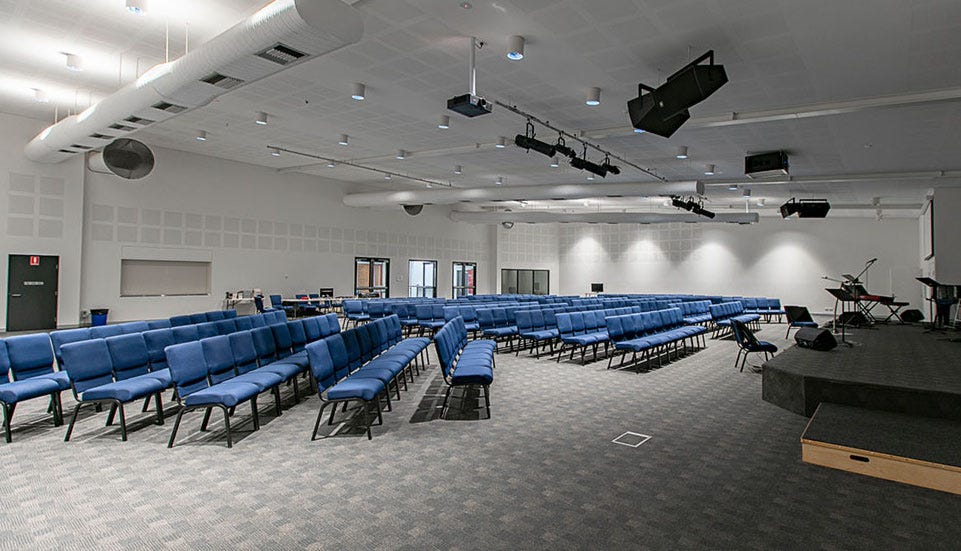After nearly a year of somewhat dissatisfying, best-we-could-do substitutes, we’re getting back to the real churchiness of church, at least in my part of the world—by which I mean the actual gathering of God’s people around his saving word. It’s marvellous.
All the same, whenever you return to something familiar after a break, you do see it with new eyes. It’s an excellent opportunity to pause and re-assess why and how we’re doing things as we do.
In that spirit, over the next three Payneful editions, I’m going to offer some miscellaneous ideas about:
leading better church meetings;
why praise makes God bigger (sounds heretical!); and
the theology of livestreaming.
This week: seven thoughts on leading better church meetings.
Leading better church meetings
The following ideas are by no means all that could be said about leading better church meetings. In fact, I wrote a meatier essay about this in The Briefing back in 2012 that you’re welcome to check out. In that longer piece, I dug more into the theology of the gathering, and why (also theologically) it’s important to be wise in how we construct them and lead them. But for now, here are seven punchy principles to provoke your thinking, and to use in discussion with your meeting leaders.
1. Be clear on what your role is as a meeting leader
The leader of a church gathering should be more than a peripheral MC or a warm-up act; but neither should they be the centre of attention.
The role and purpose of a meeting leader relates to the purpose of the church gathering as a whole. Let’s stipulate (rather than debate at this point!) that the purpose of the Sunday gathering is to meet with God in Jesus Christ as his people, and to edify one another by his Spirit, as we speak God’s word and respond to him together.
If that (or something very like it) is the case, then the role of the meeting leader is a bit like being the head of the household at a family dinner. He welcomes everyone, and oversees and facilitates all that happens, in order that the family gathering might function well and meet its goals. He doesn’t cook and serve every dish, or even the main course. But he is the one who takes responsibility to see that the whole thing goes well.
You could summarise the purpose of a meeting leader as leading the household of God in God-ward edification by the word and prayer.
This means that the role of the leader may not quite be an exercise in teaching, but that it is certainly a very important role requiring theologically discerning leadership.
2. Aim for a conceptual flow that suits the purpose of the gathering
1 Cor 14 suggests that a meeting leader should marshal the various contributions from different members of the church household into a decent, orderly edifying whole. Those contributions will usually be some form of word ministry (Bible reading, preaching, testimony, singing) or some form of response to the word (prayer, thanksgiving, singing, confession, and so on).
Just as a family dinner has a certain logic to it—nibblies then main course then dessert—so in a church meeting (or any meeting for that matter), there is a conceptual flow that makes sense of what the meeting is trying to achieve. This might be a general gospel-shaped conceptual trajectory (e.g. one that leads towards a repentant, faith-filled, listening to God’s word and then responds to that word in various ways). It also might be shaped by the particular message or theme of that particular meeting.
Every church meeting will have a conceptual trajectory of some kind—it’s really a case of whether you take the time to think about what that flow is, whether it makes sense, and whether it contributes towards the goals of the gathering.
Simply taking the time to think about how the different components of the meeting fit together, and which arrangement of them would flow best conceptually, would be a step forward for many meeting leaders.
3. Consider the emotional temperature or flow
Everything that happens in a meeting will have an emotional or affective impact on those present. There will be a fluctuation of emotional temperature as the meeting goes on. We can’t avoid this (nor would we want to).
Part of the meeting leader’s role is to reflect on this fluctuation, to respect it, and where possible to nudge it along in the most helpful way. For example, don’t program a rip-roaring song immediately before you want everyone to sit quietly and attentively to listen to a sermon. Don’t segue straight from a jaunty and hilarious announcement video into a prayer of confession. Don’t leave people sitting quietly for 30 continuous minutes and then expect them to sit quietly for another 30 minutes for the sermon. Don’t be afraid of either levity or gravity—both are beautiful in their season.
4. Pay attention to the transitions
It might actually be possible to segue from a jaunty video announcement to a time of prayer, if you allow for the appropriate transition—in this case, perhaps taking up the theme or event from the announcement, reflecting on how important it is to pray for these matters, giving people a few moments to absorb that we’re changing gears, and getting ready to approach God together in prayer, inviting the pray-er to come forward, and so on. By the time you’ve done this—it might only have taken 60 seconds—the congregation might be ready for the emotional and conceptual pivot from announcement to prayer.
Think about every transition between elements in the meeting. Think about them logistically, conceptually and emotionally. Is some kind of thread needed to stitch one piece to the next?
5. Be gracious to household guests
After you’ve prepared the run sheet for your meeting, and thought about how it all flows and fits together, and considered the transitions, and figured out what you’re going to say at various points—go back to the beginning and think through the whole thing again from the perspective of the guest or the outsider. Would it make sense to them? What aspects would be gobbledygook to them? Would they feel welcomed and included as guests at our household gathering?
6. Train your contributors
This seems like a statement of the bleedin’ obvious, but since it is so rarely done, the obvious needs to be said: if we were to offer appropriate training to those who are going to serve during the meeting, not only would they be encouraged, supported and boosted in their confidence, they would be more likely to do a good and edifying job!
To take just one example: it astonishes me just a touch that so few churches offer any guidelines or training for those who are going to read the Bible aloud during the church meeting. It is surely one of the high points of the whole gathering—to sit and listen together to God’s word being read—but most churches don’t seem to treat as such. They don’t look for people who are gifted in reading aloud (some of us are, some aren’t), and they provide no training in how to do it more effectively.
(If you’re looking for a solution here, the best—in fact only one—I know of is this short two-session training program from Matthias Media: Reading the Bible Aloud. See some further details below in the PS.)
7. Lead in real time
No battle plan, they say, survives first contact with the enemy. Thoughtful preparation is important, but leading a meeting also means leading in real time, as events unfold.
When it becomes apparent, for example, that things are running over time, and you won’t be able to fit everything in, it’s your job to assess the situation and make the call to drop the last song, or to run past your normal finish time, or whatever it might be.
When some tragic news is shared, and it’s obvious that people are upset and need some time to recover, it’s your job to pause the meeting, lead in prayer, and take a three minute break.
Like any good host, a meeting leader is attentive.
He notices, he cares, and he steps in to do whatever would be best for the household of God and their guests.
PS
What’s the standard of meeting leading like in your part of the world? Do you have any good ideas or tips to share? Make a comment, or send me an email (and I’ll share your wisdom around).
By the way, it seems that the training program I recommend above on Reading the Bible Aloud is on sale at 50% off at the moment at Matthias Media. Not sure how long this will last, but get in quick if you can! There’s a booklet and a DVD (remember those?).
I’ve developed a number of ‘church meeting templates’ over the years that reflect the principles above. Later this week, I’ll send them around as a ‘Payneful Extra’.
This is a partner only post, but (as always) feel free to make good use of it in your ministries—but you’ll have to do it old school. You can forward the email (with the text in it), print it out, cut-and-paste it … whatever. But if you just send someone the web link, or share the link on social media, they won’t be able to view the post online.












